sensor BMW 4 SERIES CONVERTIBLE 2015 F33 Owner's Manual
[x] Cancel search | Manufacturer: BMW, Model Year: 2015, Model line: 4 SERIES CONVERTIBLE, Model: BMW 4 SERIES CONVERTIBLE 2015 F33Pages: 247, PDF Size: 5.22 MB
Page 19 of 247
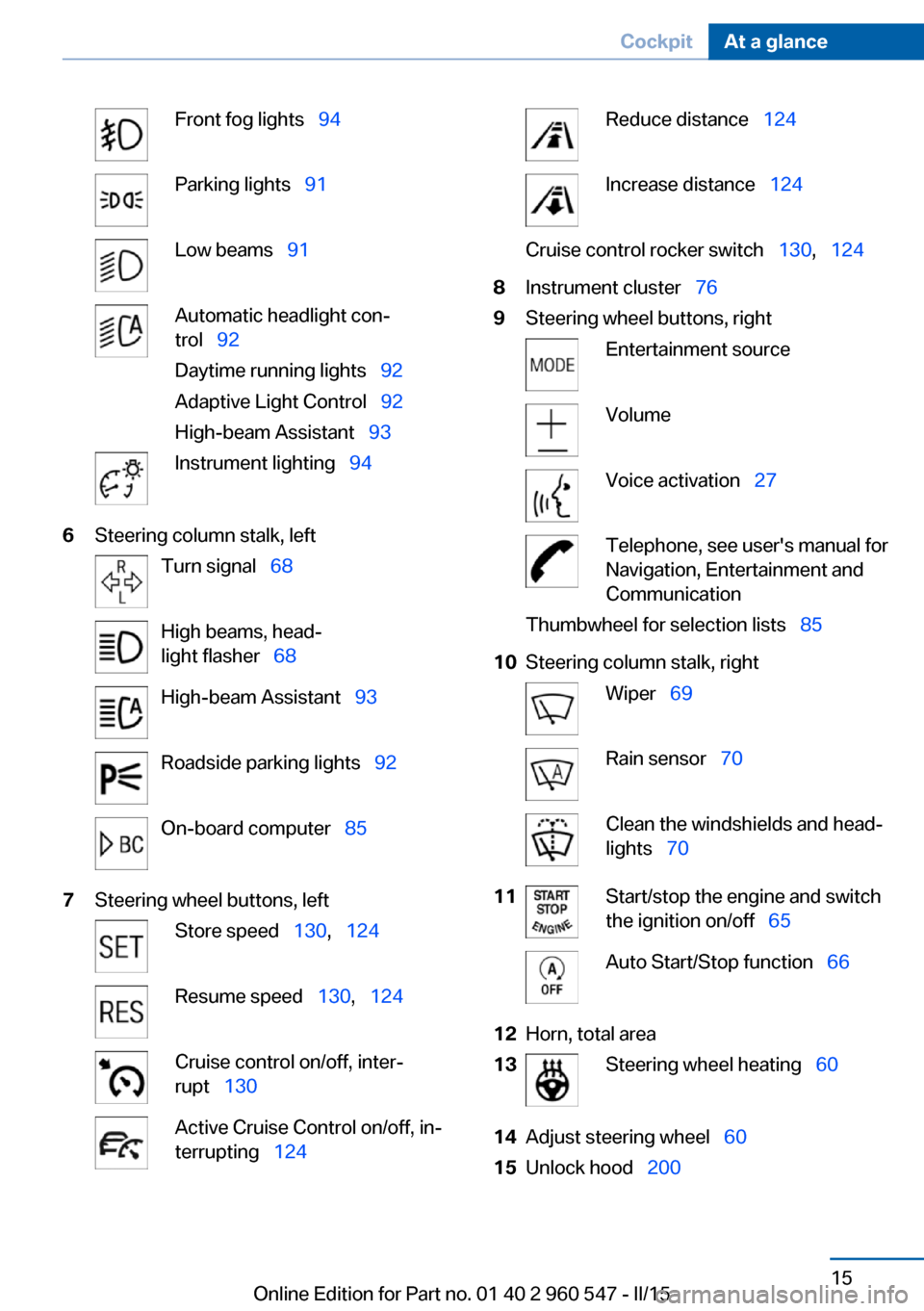
Front fog lights‚Äā‚ÄÖ94Parking lights‚Äā‚ÄÖ91Low beams‚Äā‚ÄÖ91Automatic headlight con‚Äź
trol‚Äā‚ÄÖ 92
Daytime running lights‚Äā‚ÄÖ 92
Adaptive Light Control‚Äā‚ÄÖ 92
High-beam Assistant‚Äā‚ÄÖ 93Instrument lighting‚Äā‚ÄÖ946Steering column stalk, leftTurn signal‚Äā‚ÄÖ68High beams, head‚Äź
light flasher‚Äā‚ÄÖ 68High-beam Assistant‚Äā‚ÄÖ 93Roadside parking lights‚Äā‚ÄÖ 92On-board computer‚Äā‚ÄÖ857Steering wheel buttons, leftStore speed‚Äā‚ÄÖ130,‚Äā‚ÄÖ124Resume speed‚Äā‚ÄÖ 130,‚Äā‚ÄÖ124Cruise control on/off, inter‚Äź
rupt‚Äā‚ÄÖ 130Active Cruise Control on/off, in‚Äź
terrupting‚Äā‚ÄÖ 124Reduce distance‚Äā‚ÄÖ 124Increase distance‚Äā‚ÄÖ 124Cruise control rocker switch‚Äā‚ÄÖ 130,‚Äā‚ÄÖ1248Instrument cluster‚Äā‚ÄÖ 769Steering wheel buttons, rightEntertainment sourceVolumeVoice activation‚Äā‚ÄÖ27Telephone, see user's manual for
Navigation, Entertainment and
CommunicationThumbwheel for selection lists‚Äā‚ÄÖ 8510Steering column stalk, rightWiper‚Äā‚ÄÖ69Rain sensor‚Äā‚ÄÖ 70Clean the windshields and head‚Äź
lights‚Äā‚ÄÖ 7011Start/stop the engine and switch
the ignition on/off‚Äā‚ÄÖ 65Auto Start/Stop function‚Äā‚ÄÖ 6612Horn, total area13Steering wheel heating‚Äā‚ÄÖ6014Adjust steering wheel‚Äā‚ÄÖ6015Unlock hood‚Äā‚ÄÖ200Seite 15CockpitAt a glance15
Online Edition for Part no. 01 40 2 960 547 - II/15
Page 42 of 247
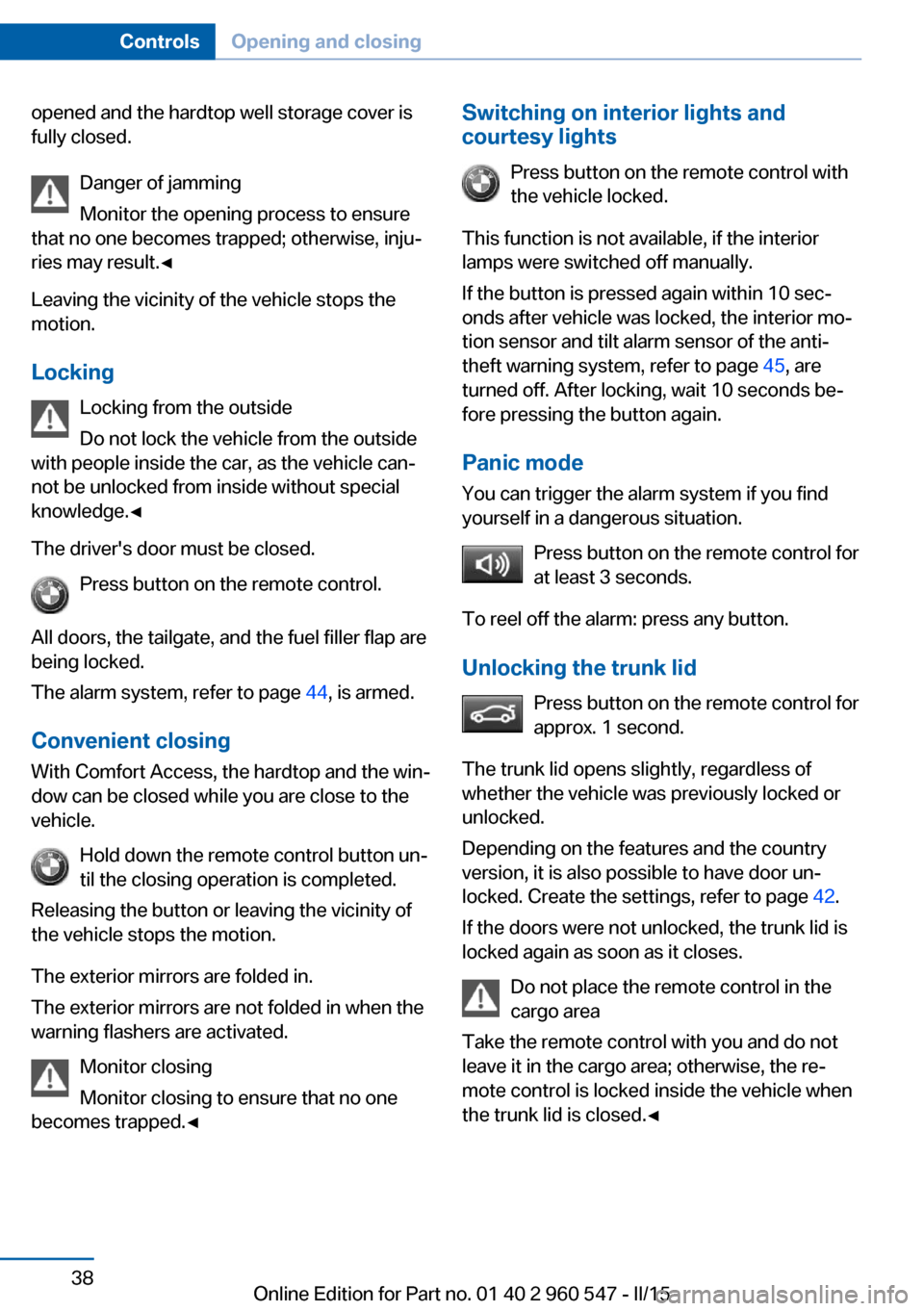
opened and the hardtop well storage cover is
fully closed.
Danger of jamming
Monitor the opening process to ensure
that no one becomes trapped; otherwise, inju‚Äź
ries may result.‚óÄ
Leaving the vicinity of the vehicle stops the
motion.
Locking Locking from the outside
Do not lock the vehicle from the outside
with people inside the car, as the vehicle can‚Äź
not be unlocked from inside without special knowledge.‚óÄ
The driver's door must be closed. Press button on the remote control.
All doors, the tailgate, and the fuel filler flap are
being locked.
The alarm system, refer to page 44, is armed.
Convenient closing With Comfort Access, the hardtop and the win‚Äź
dow can be closed while you are close to the
vehicle.
Hold down the remote control button un‚Äź
til the closing operation is completed.
Releasing the button or leaving the vicinity of
the vehicle stops the motion.
The exterior mirrors are folded in.
The exterior mirrors are not folded in when the
warning flashers are activated.
Monitor closing
Monitor closing to ensure that no one
becomes trapped.‚óÄSwitching on interior lights and
courtesy lights
Press button on the remote control with
the vehicle locked.
This function is not available, if the interior
lamps were switched off manually.
If the button is pressed again within 10 sec‚Äź
onds after vehicle was locked, the interior mo‚Äź
tion sensor and tilt alarm sensor of the anti-
theft warning system, refer to page 45, are
turned off. After locking, wait 10 seconds be‚Äź
fore pressing the button again.
Panic mode
You can trigger the alarm system if you find
yourself in a dangerous situation.
Press button on the remote control for
at least 3 seconds.
To reel off the alarm: press any button.
Unlocking the trunk lid Press button on the remote control for
approx. 1 second.
The trunk lid opens slightly, regardless of
whether the vehicle was previously locked or
unlocked.
Depending on the features and the country
version, it is also possible to have door un‚Äź
locked. Create the settings, refer to page 42.
If the doors were not unlocked, the trunk lid is
locked again as soon as it closes.
Do not place the remote control in the
cargo area
Take the remote control with you and do not
leave it in the cargo area; otherwise, the re‚Äź
mote control is locked inside the vehicle when
the trunk lid is closed.‚óÄSeite 38ControlsOpening and closing38
Online Edition for Part no. 01 40 2 960 547 - II/15
Page 48 of 247
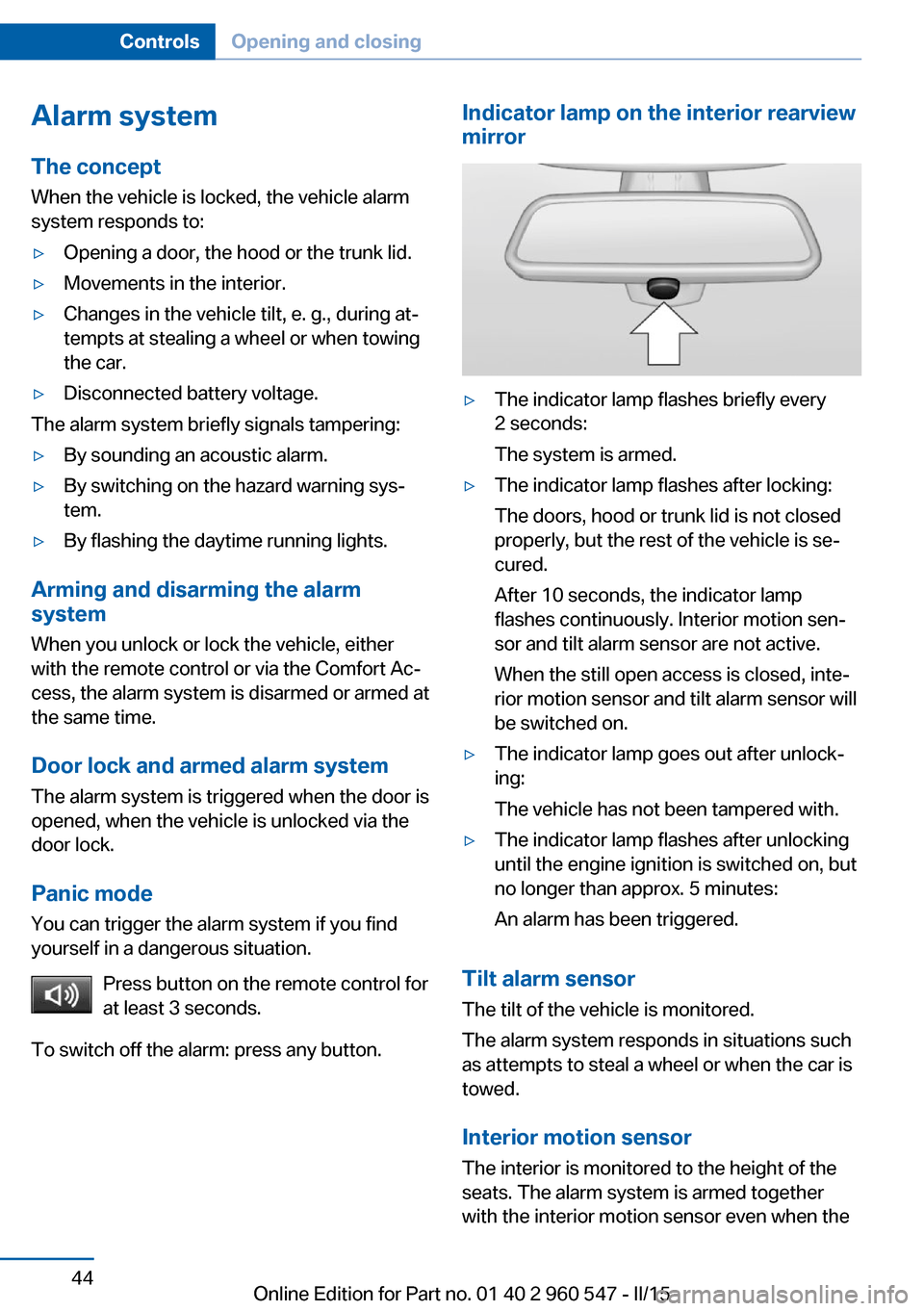
Alarm systemThe conceptWhen the vehicle is locked, the vehicle alarm
system responds to:‚Ė∑Opening a door, the hood or the trunk lid.‚Ė∑Movements in the interior.‚Ė∑Changes in the vehicle tilt, e. g., during at‚Äź
tempts at stealing a wheel or when towing
the car.‚Ė∑Disconnected battery voltage.
The alarm system briefly signals tampering:
‚Ė∑By sounding an acoustic alarm.‚Ė∑By switching on the hazard warning sys‚Äź
tem.‚Ė∑By flashing the daytime running lights.
Arming and disarming the alarm
system
When you unlock or lock the vehicle, either
with the remote control or via the Comfort Ac‚Äź
cess, the alarm system is disarmed or armed at
the same time.
Door lock and armed alarm systemThe alarm system is triggered when the door is
opened, when the vehicle is unlocked via the
door lock.
Panic mode You can trigger the alarm system if you find
yourself in a dangerous situation.
Press button on the remote control for
at least 3 seconds.
To switch off the alarm: press any button.
Indicator lamp on the interior rearview
mirror‚Ė∑The indicator lamp flashes briefly every
2 seconds:
The system is armed.‚Ė∑The indicator lamp flashes after locking:
The doors, hood or trunk lid is not closed
properly, but the rest of the vehicle is se‚Äź
cured.
After 10 seconds, the indicator lamp
flashes continuously. Interior motion sen‚Äź
sor and tilt alarm sensor are not active.
When the still open access is closed, inte‚Äź
rior motion sensor and tilt alarm sensor will
be switched on.‚Ė∑The indicator lamp goes out after unlock‚Äź
ing:
The vehicle has not been tampered with.‚Ė∑The indicator lamp flashes after unlocking
until the engine ignition is switched on, but
no longer than approx. 5 minutes:
An alarm has been triggered.
Tilt alarm sensor The tilt of the vehicle is monitored.
The alarm system responds in situations such
as attempts to steal a wheel or when the car is
towed.
Interior motion sensor The interior is monitored to the height of the
seats. The alarm system is armed together
with the interior motion sensor even when the
Seite 44ControlsOpening and closing44
Online Edition for Part no. 01 40 2 960 547 - II/15
Page 49 of 247
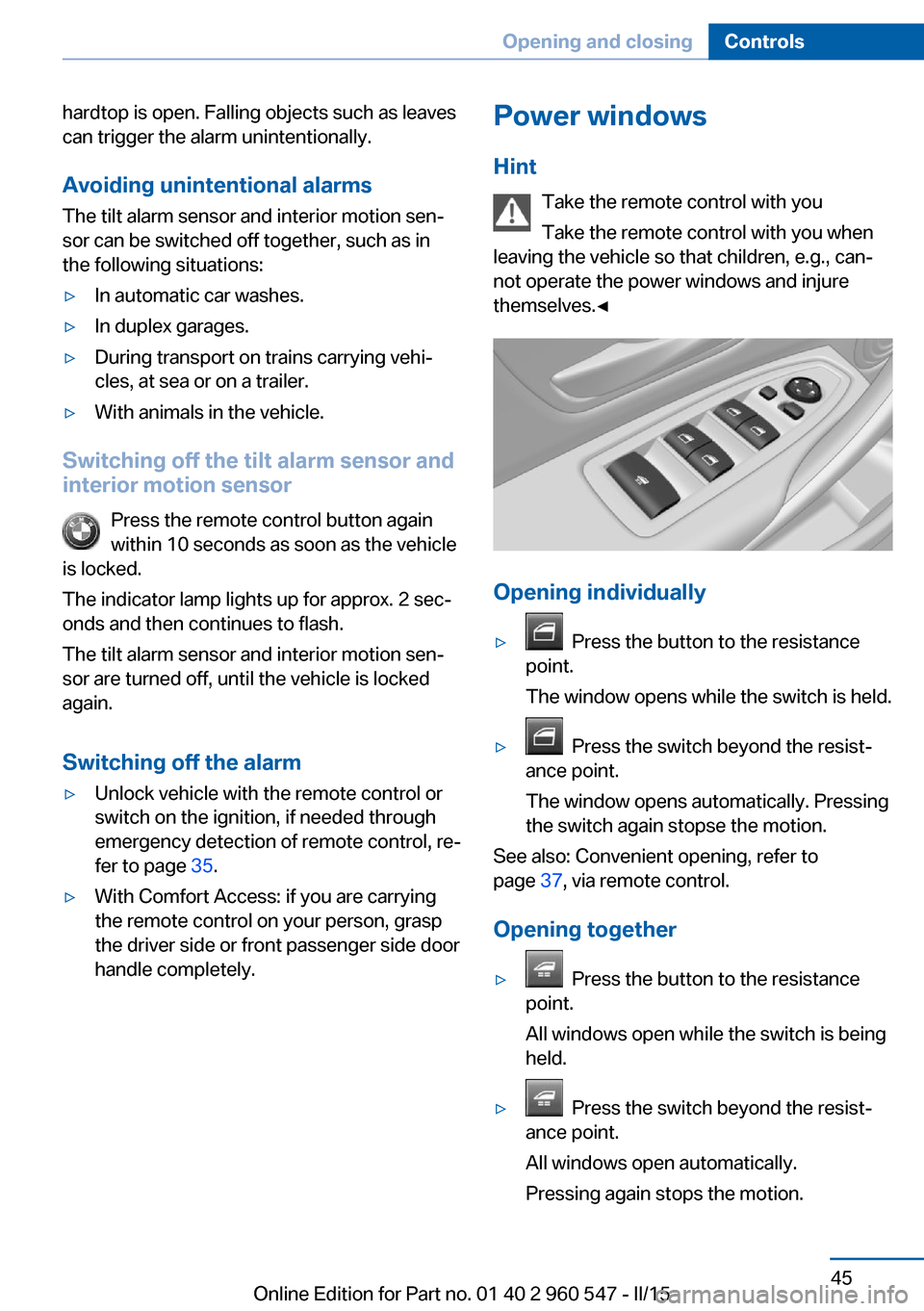
hardtop is open. Falling objects such as leaves
can trigger the alarm unintentionally.
Avoiding unintentional alarms
The tilt alarm sensor and interior motion sen‚Äź
sor can be switched off together, such as in
the following situations:‚Ė∑In automatic car washes.‚Ė∑In duplex garages.‚Ė∑During transport on trains carrying vehi‚Äź
cles, at sea or on a trailer.‚Ė∑With animals in the vehicle.
Switching off the tilt alarm sensor and
interior motion sensor
Press the remote control button again
within 10 seconds as soon as the vehicle
is locked.
The indicator lamp lights up for approx. 2 sec‚Äź
onds and then continues to flash.
The tilt alarm sensor and interior motion sen‚Äź
sor are turned off, until the vehicle is locked again.
Switching off the alarm
‚Ė∑Unlock vehicle with the remote control or
switch on the ignition, if needed through
emergency detection of remote control, re‚Äź
fer to page 35.‚Ė∑With Comfort Access: if you are carrying
the remote control on your person, grasp
the driver side or front passenger side door
handle completely.Power windows
Hint Take the remote control with you
Take the remote control with you when
leaving the vehicle so that children, e.g., can‚Äź
not operate the power windows and injure
themselves.‚óÄ
Opening individually
‚Ė∑ Press the button to the resistance
point.
The window opens while the switch is held.‚Ė∑ Press the switch beyond the resist‚Äź
ance point.
The window opens automatically. Pressing
the switch again stopse the motion.
See also: Convenient opening, refer to
page 37, via remote control.
Opening together
‚Ė∑ Press the button to the resistance
point.
All windows open while the switch is being
held.‚Ė∑ Press the switch beyond the resist‚Äź
ance point.
All windows open automatically.
Pressing again stops the motion.
Seite 45Opening and closingControls45
Online Edition for Part no. 01 40 2 960 547 - II/15
Page 74 of 247
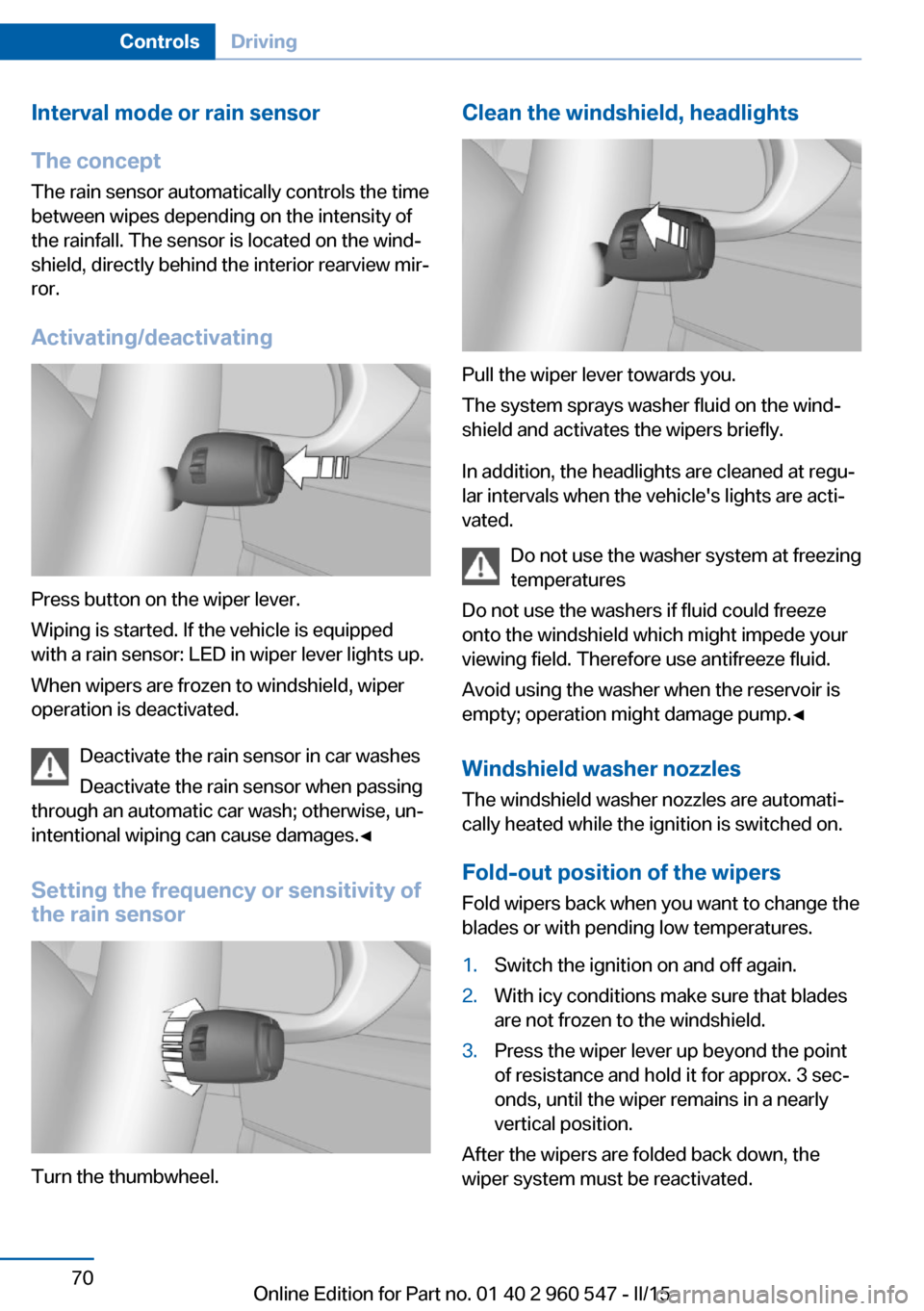
Interval mode or rain sensor
The concept The rain sensor automatically controls the time
between wipes depending on the intensity of the rainfall. The sensor is located on the wind‚Äź
shield, directly behind the interior rearview mir‚Äź
ror.
Activating/deactivating
Press button on the wiper lever.
Wiping is started. If the vehicle is equipped
with a rain sensor: LED in wiper lever lights up.
When wipers are frozen to windshield, wiper
operation is deactivated.
Deactivate the rain sensor in car washes
Deactivate the rain sensor when passing
through an automatic car wash; otherwise, un‚Äź
intentional wiping can cause damages.‚óÄ
Setting the frequency or sensitivity of
the rain sensor
Turn the thumbwheel.
Clean the windshield, headlights
Pull the wiper lever towards you.
The system sprays washer fluid on the wind‚Äź
shield and activates the wipers briefly.
In addition, the headlights are cleaned at regu‚Äź
lar intervals when the vehicle's lights are acti‚Äź
vated.
Do not use the washer system at freezing
temperatures
Do not use the washers if fluid could freeze
onto the windshield which might impede your
viewing field. Therefore use antifreeze fluid.
Avoid using the washer when the reservoir is
empty; operation might damage pump.‚óÄ
Windshield washer nozzles The windshield washer nozzles are automati‚Äź
cally heated while the ignition is switched on.
Fold-out position of the wipers Fold wipers back when you want to change the
blades or with pending low temperatures.
1.Switch the ignition on and off again.2.With icy conditions make sure that blades
are not frozen to the windshield.3.Press the wiper lever up beyond the point
of resistance and hold it for approx. 3 sec‚Äź
onds, until the wiper remains in a nearly
vertical position.
After the wipers are folded back down, the
wiper system must be reactivated.
Seite 70ControlsDriving70
Online Edition for Part no. 01 40 2 960 547 - II/15
Page 87 of 247
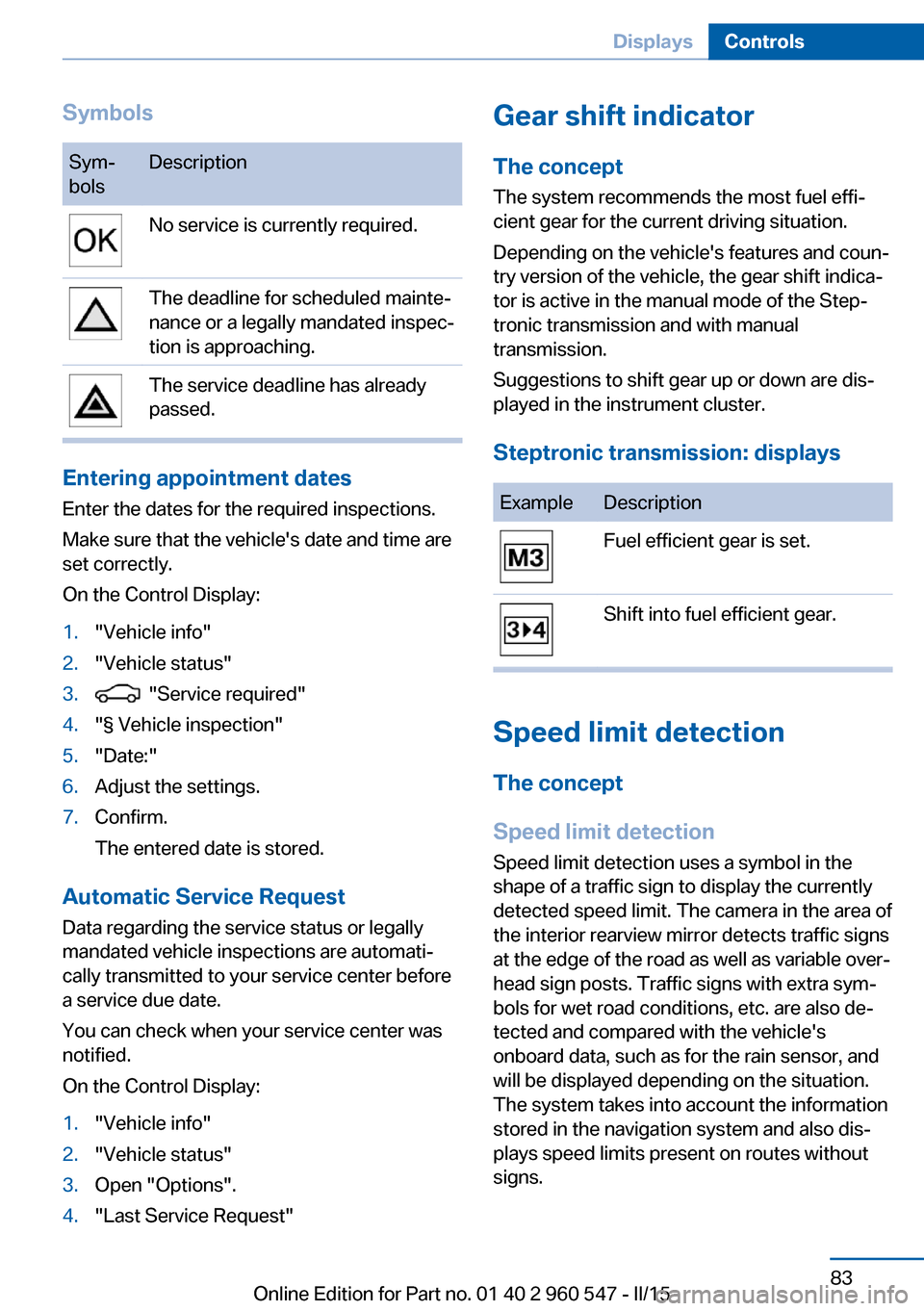
SymbolsSym‚Äź
bolsDescriptionNo service is currently required.The deadline for scheduled mainte‚Äź
nance or a legally mandated inspec‚Äź
tion is approaching.The service deadline has already
passed.
Entering appointment dates
Enter the dates for the required inspections.
Make sure that the vehicle's date and time are
set correctly.
On the Control Display:
1."Vehicle info"2."Vehicle status"3. "Service required"4."§ Vehicle inspection"5."Date:"6.Adjust the settings.7.Confirm.
The entered date is stored.
Automatic Service Request
Data regarding the service status or legally
mandated vehicle inspections are automati‚Äź
cally transmitted to your service center before
a service due date.
You can check when your service center was
notified.
On the Control Display:
1."Vehicle info"2."Vehicle status"3.Open "Options".4."Last Service Request"Gear shift indicator
The conceptThe system recommends the most fuel effi‚Äź
cient gear for the current driving situation.
Depending on the vehicle's features and coun‚Äź
try version of the vehicle, the gear shift indica‚Äź
tor is active in the manual mode of the Step‚Äź
tronic transmission and with manual
transmission.
Suggestions to shift gear up or down are dis‚Äź
played in the instrument cluster.
Steptronic transmission: displaysExampleDescriptionFuel efficient gear is set.Shift into fuel efficient gear.
Speed limit detection
The concept
Speed limit detection
Speed limit detection uses a symbol in the
shape of a traffic sign to display the currently
detected speed limit. The camera in the area of
the interior rearview mirror detects traffic signs
at the edge of the road as well as variable over‚Äź
head sign posts. Traffic signs with extra sym‚Äź
bols for wet road conditions, etc. are also de‚Äź
tected and compared with the vehicle's
onboard data, such as for the rain sensor, and
will be displayed depending on the situation.
The system takes into account the information
stored in the navigation system and also dis‚Äź
plays speed limits present on routes without
signs.
Seite 83DisplaysControls83
Online Edition for Part no. 01 40 2 960 547 - II/15
Page 96 of 247
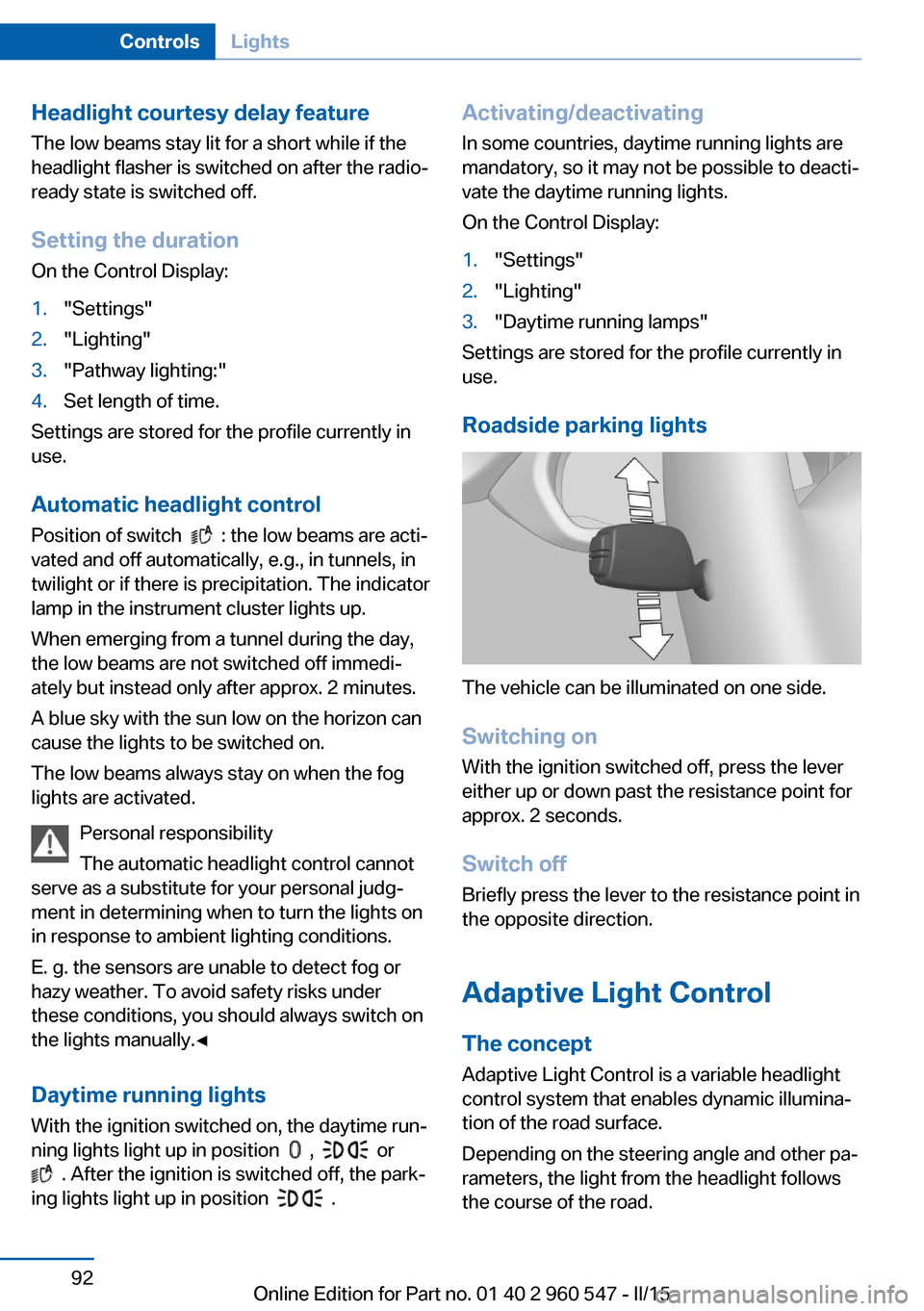
Headlight courtesy delay featureThe low beams stay lit for a short while if the
headlight flasher is switched on after the radio-
ready state is switched off.
Setting the duration
On the Control Display:1."Settings"2."Lighting"3."Pathway lighting:"4.Set length of time.
Settings are stored for the profile currently in
use.
Automatic headlight control
Position of switch
: the low beams are acti‚Äź
vated and off automatically, e.g., in tunnels, in
twilight or if there is precipitation. The indicator
lamp in the instrument cluster lights up.
When emerging from a tunnel during the day,
the low beams are not switched off immedi‚Äź
ately but instead only after approx. 2 minutes.
A blue sky with the sun low on the horizon can
cause the lights to be switched on.
The low beams always stay on when the fog
lights are activated.
Personal responsibility
The automatic headlight control cannot
serve as a substitute for your personal judg‚Äź
ment in determining when to turn the lights on
in response to ambient lighting conditions.
E. g. the sensors are unable to detect fog or
hazy weather. To avoid safety risks under
these conditions, you should always switch on
the lights manually.‚óÄ
Daytime running lights With the ignition switched on, the daytime run‚Äź
ning lights light up in position
, or
. After the ignition is switched off, the park‚Äź
ing lights light up in position
.
Activating/deactivating
In some countries, daytime running lights are
mandatory, so it may not be possible to deacti‚Äź
vate the daytime running lights.
On the Control Display:1."Settings"2."Lighting"3."Daytime running lamps"
Settings are stored for the profile currently in
use.
Roadside parking lights
The vehicle can be illuminated on one side.
Switching on With the ignition switched off, press the lever
either up or down past the resistance point for
approx. 2 seconds.
Switch off Briefly press the lever to the resistance point in
the opposite direction.
Adaptive Light Control The concept
Adaptive Light Control is a variable headlight
control system that enables dynamic illumina‚Äź
tion of the road surface.
Depending on the steering angle and other pa‚Äź rameters, the light from the headlight follows
the course of the road.
Seite 92ControlsLights92
Online Edition for Part no. 01 40 2 960 547 - II/15
Page 104 of 247
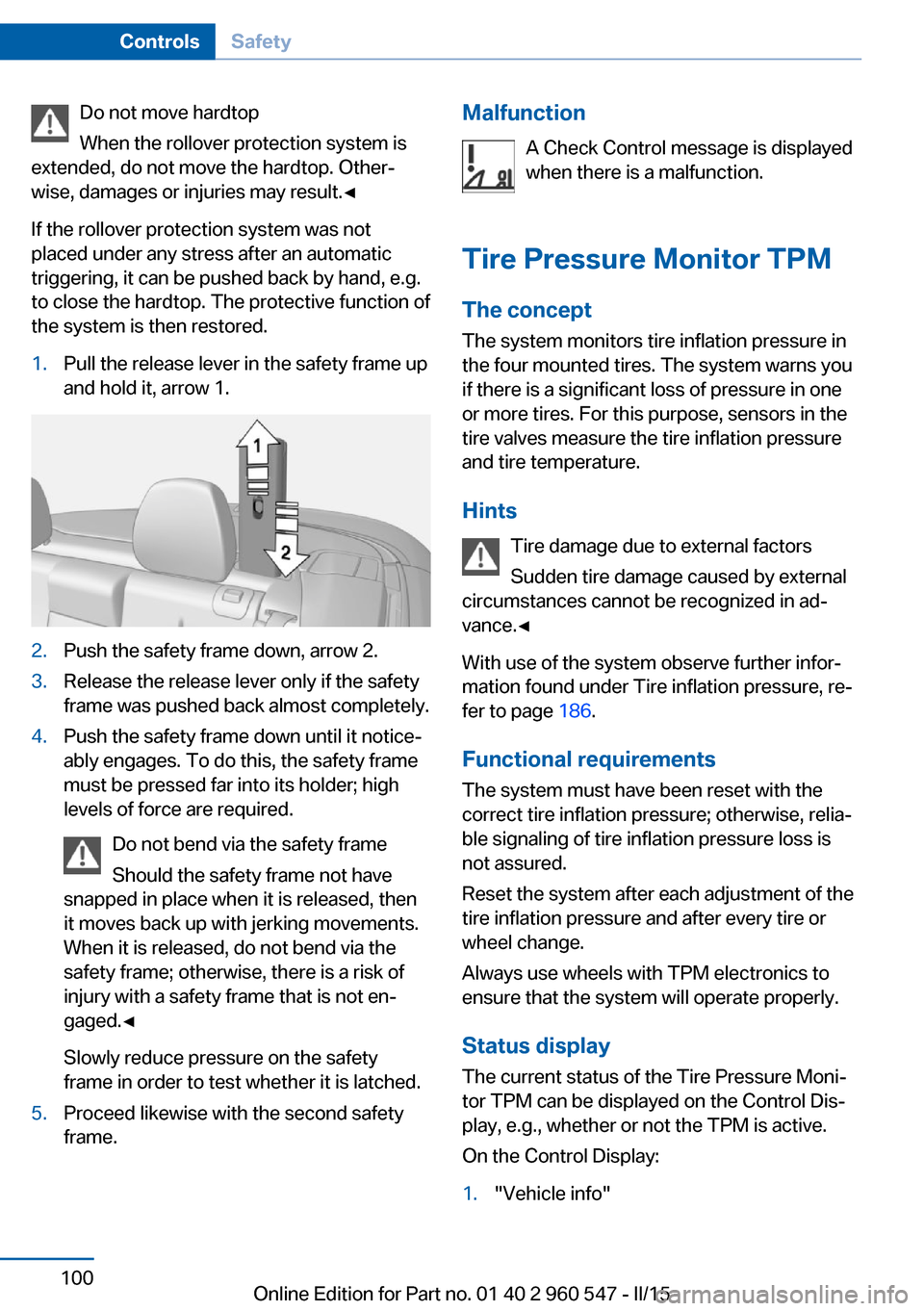
Do not move hardtop
When the rollover protection system is
extended, do not move the hardtop. Other‚Äź
wise, damages or injuries may result.‚óÄ
If the rollover protection system was not
placed under any stress after an automatic
triggering, it can be pushed back by hand, e.g.
to close the hardtop. The protective function of
the system is then restored.1.Pull the release lever in the safety frame up
and hold it, arrow 1.2.Push the safety frame down, arrow 2.3.Release the release lever only if the safety
frame was pushed back almost completely.4.Push the safety frame down until it notice‚Äź
ably engages. To do this, the safety frame
must be pressed far into its holder; high
levels of force are required.
Do not bend via the safety frame
Should the safety frame not have
snapped in place when it is released, then
it moves back up with jerking movements.
When it is released, do not bend via the
safety frame; otherwise, there is a risk of
injury with a safety frame that is not en‚Äź
gaged.‚óÄ
Slowly reduce pressure on the safety
frame in order to test whether it is latched.5.Proceed likewise with the second safety
frame.Malfunction
A Check Control message is displayed
when there is a malfunction.
Tire Pressure Monitor TPM The concept
The system monitors tire inflation pressure in
the four mounted tires. The system warns you
if there is a significant loss of pressure in one
or more tires. For this purpose, sensors in the
tire valves measure the tire inflation pressure
and tire temperature.
Hints Tire damage due to external factors
Sudden tire damage caused by external
circumstances cannot be recognized in ad‚Äź
vance.‚óÄ
With use of the system observe further infor‚Äź
mation found under Tire inflation pressure, re‚Äź
fer to page 186.
Functional requirements
The system must have been reset with the
correct tire inflation pressure; otherwise, relia‚Äź
ble signaling of tire inflation pressure loss is
not assured.
Reset the system after each adjustment of the
tire inflation pressure and after every tire or
wheel change.
Always use wheels with TPM electronics to
ensure that the system will operate properly.
Status display
The current status of the Tire Pressure Moni‚Äź
tor TPM can be displayed on the Control Dis‚Äź
play, e.g., whether or not the TPM is active.
On the Control Display:1."Vehicle info"Seite 100ControlsSafety100
Online Edition for Part no. 01 40 2 960 547 - II/15
Page 113 of 247
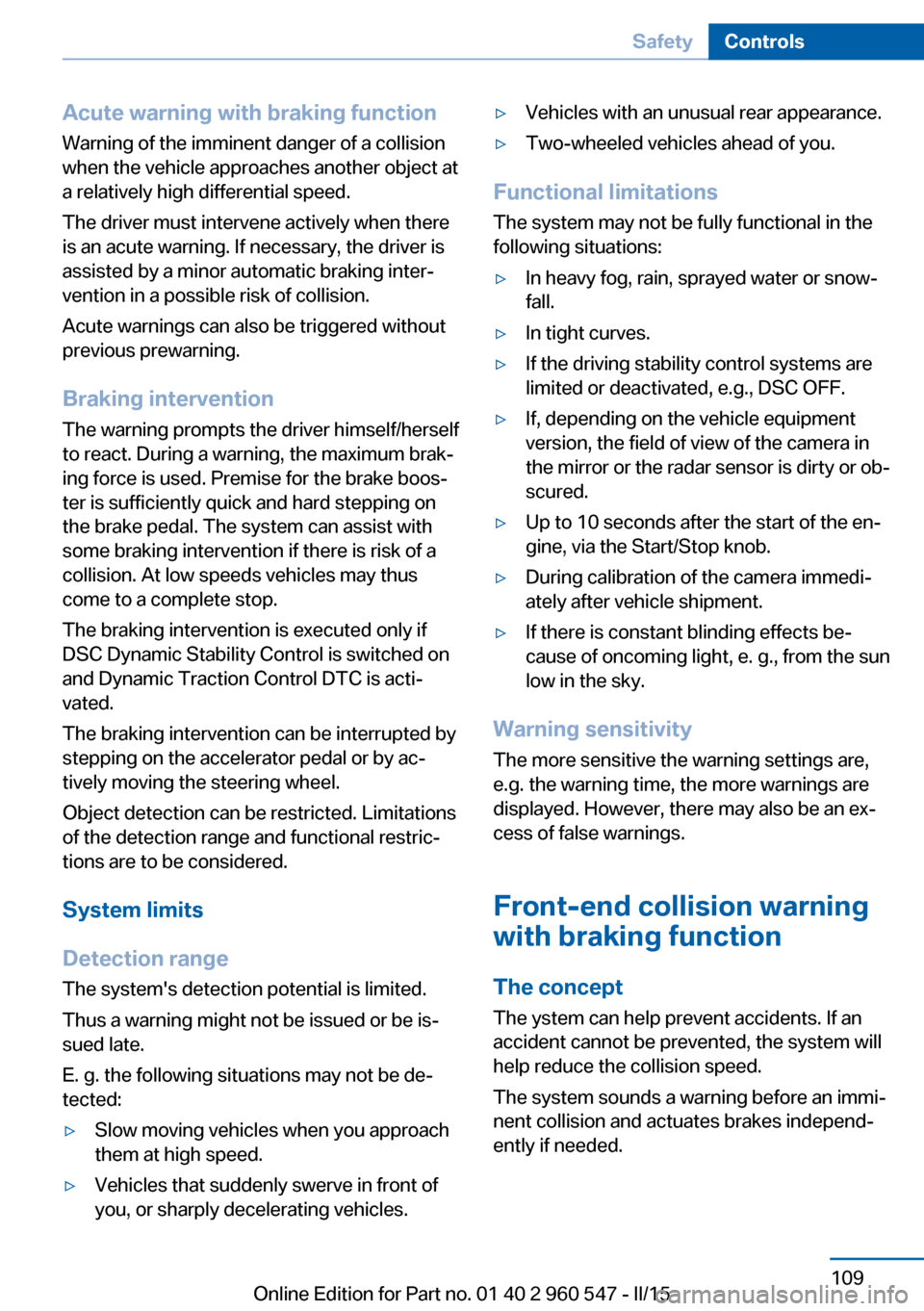
Acute warning with braking function
Warning of the imminent danger of a collision
when the vehicle approaches another object at
a relatively high differential speed.
The driver must intervene actively when there
is an acute warning. If necessary, the driver is
assisted by a minor automatic braking inter‚Äź
vention in a possible risk of collision.
Acute warnings can also be triggered without
previous prewarning.
Braking intervention
The warning prompts the driver himself/herself
to react. During a warning, the maximum brak‚Äź
ing force is used. Premise for the brake boos‚Äź
ter is sufficiently quick and hard stepping on
the brake pedal. The system can assist with
some braking intervention if there is risk of a
collision. At low speeds vehicles may thus
come to a complete stop.
The braking intervention is executed only if
DSC Dynamic Stability Control is switched on
and Dynamic Traction Control DTC is acti‚Äź
vated.
The braking intervention can be interrupted by
stepping on the accelerator pedal or by ac‚Äź
tively moving the steering wheel.
Object detection can be restricted. Limitations
of the detection range and functional restric‚Äź
tions are to be considered.
System limits
Detection range
The system's detection potential is limited.
Thus a warning might not be issued or be is‚Äź
sued late.
E. g. the following situations may not be de‚Äź
tected:‚Ė∑Slow moving vehicles when you approach
them at high speed.‚Ė∑Vehicles that suddenly swerve in front of
you, or sharply decelerating vehicles.‚Ė∑Vehicles with an unusual rear appearance.‚Ė∑Two-wheeled vehicles ahead of you.
Functional limitations
The system may not be fully functional in the
following situations:
‚Ė∑In heavy fog, rain, sprayed water or snow‚Äź
fall.‚Ė∑In tight curves.‚Ė∑If the driving stability control systems are
limited or deactivated, e.g., DSC OFF.‚Ė∑If, depending on the vehicle equipment
version, the field of view of the camera in
the mirror or the radar sensor is dirty or ob‚Äź
scured.‚Ė∑Up to 10 seconds after the start of the en‚Äź
gine, via the Start/Stop knob.‚Ė∑During calibration of the camera immedi‚Äź
ately after vehicle shipment.‚Ė∑If there is constant blinding effects be‚Äź
cause of oncoming light, e. g., from the sun
low in the sky.
Warning sensitivity
The more sensitive the warning settings are,
e.g. the warning time, the more warnings are
displayed. However, there may also be an ex‚Äź
cess of false warnings.
Front-end collision warning
with braking function
The concept The ystem can help prevent accidents. If an
accident cannot be prevented, the system will help reduce the collision speed.
The system sounds a warning before an immi‚Äź
nent collision and actuates brakes independ‚Äź
ently if needed.
Seite 109SafetyControls109
Online Edition for Part no. 01 40 2 960 547 - II/15
Page 114 of 247
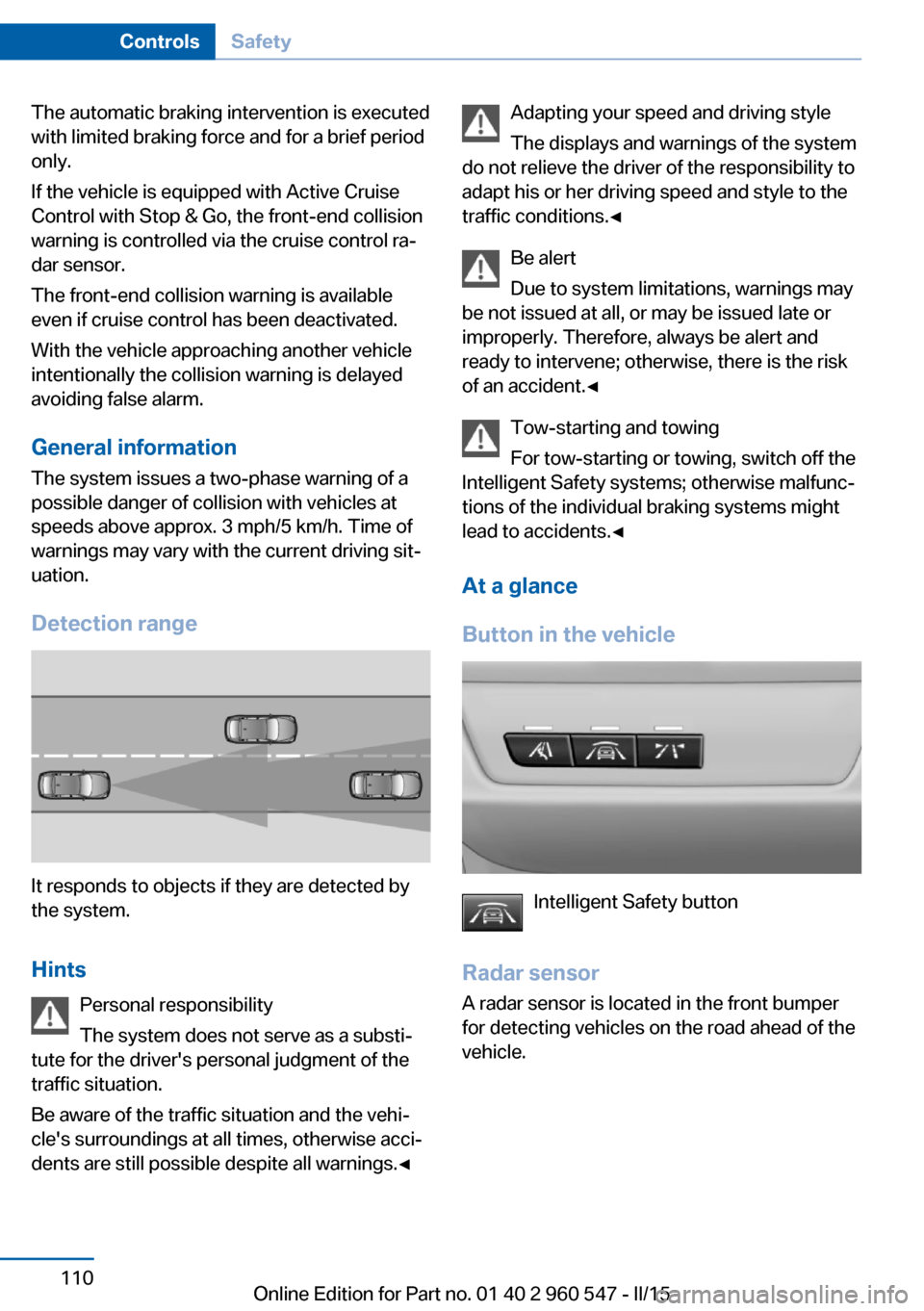
The automatic braking intervention is executed
with limited braking force and for a brief period
only.
If the vehicle is equipped with Active Cruise
Control with Stop & Go, the front-end collision
warning is controlled via the cruise control ra‚Äź
dar sensor.
The front-end collision warning is available
even if cruise control has been deactivated.
With the vehicle approaching another vehicle
intentionally the collision warning is delayed
avoiding false alarm.
General information
The system issues a two-phase warning of a
possible danger of collision with vehicles at
speeds above approx. 3 mph/5 km/h. Time of
warnings may vary with the current driving sit‚Äź
uation.
Detection range
It responds to objects if they are detected by
the system.
Hints Personal responsibility
The system does not serve as a substi‚Äź
tute for the driver's personal judgment of the
traffic situation.
Be aware of the traffic situation and the vehi‚Äź
cle's surroundings at all times, otherwise acci‚Äź
dents are still possible despite all warnings.‚óÄ
Adapting your speed and driving style
The displays and warnings of the system
do not relieve the driver of the responsibility to
adapt his or her driving speed and style to the
traffic conditions.‚óÄ
Be alert
Due to system limitations, warnings may
be not issued at all, or may be issued late or
improperly. Therefore, always be alert and
ready to intervene; otherwise, there is the risk
of an accident.‚óÄ
Tow-starting and towing
For tow-starting or towing, switch off the
Intelligent Safety systems; otherwise malfunc‚Äź
tions of the individual braking systems might
lead to accidents.‚óÄ
At a glance
Button in the vehicle
Intelligent Safety button
Radar sensor
A radar sensor is located in the front bumper
for detecting vehicles on the road ahead of the
vehicle.
Seite 110ControlsSafety110
Online Edition for Part no. 01 40 2 960 547 - II/15